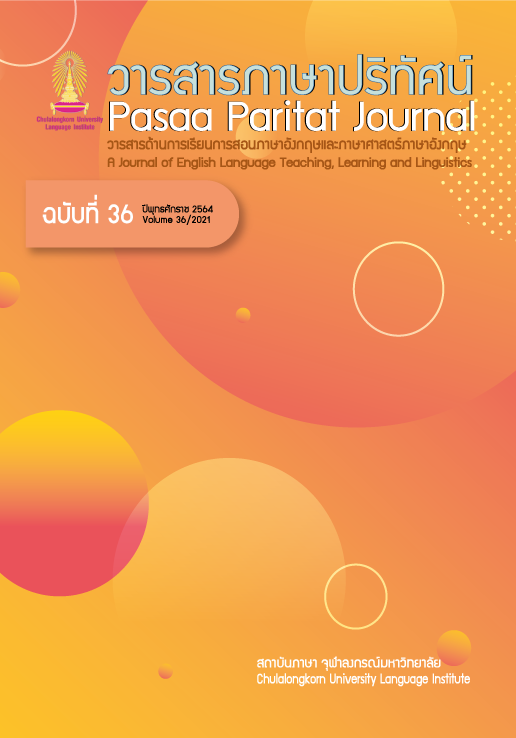Voices of ASEAN Teachers of English regarding Target Variety Issues of English as the Official Language of the ASEAN Community
DOI:
https://doi.org/10.58837/CHULA.PPJ.36.3Keywords:
ELT in ASEAN, Teachers’ Attitude, English Target Variety, EILAbstract
This study investigates the uses of various Englishes throughout the Association of Southeast Asian Nations (ASEAN) with a view to re-imagining teaching English in the ASEAN countries. The study researches the varieties of English, English language teaching models, roles, and discrepancies of English in the ASEAN countries through 374 practitioners from ten ASEAN member countries via questionnaires and six focus group interviews with 28 interviewees. Respondents expressed their attitudes toward English varieties they learned, and the reasons English was currently taught and learned in their contexts, English varieties they taught, factors influencing their teaching preferences, and English varieties for their future teaching preferences. During the focus group interviews, interviewees shared their thoughts regarding concepts of a standard variety of English , and definition of terms i.e., varieties of British (BrE) and American English (AmE), English as an International Language (EIL), and English as a Lingual Franca (ELF). Findings portrayed the strong beliefs in AmE and BrE varieties which conflicted with the linguistic reality in the region. Issues in terms of identity, native or non-native English teachers, and English ownership were mentioned, and the notions of ELF and EIL among the interviewees were unclear. Further discussions regarding an English Language Teaching (ELT) reconceptualization as the steppingstone for ELT in the current and the future globalization were provided.
References
Borg, S. (2003). Teacher cognition in language teaching: A review of research on what language teachers think, know, believe, and do.
Language teaching, 36(02), 81-109.
Borlongan. (2009). A Survey on Language Use, Attitudes, and Identity in Relation to Philippine English among Young Generation Filipinos:
An Initial Sample from a Private University. Philippine ESL Journal, 3(August), 74-107.
Darasawang, P., & Watson Todd, R. (2012). The effect of policy on English language teaching at secondary schools in Thailand. In E.-L. Low,
Hashim, A (Ed.), English in Southeast Asia: Features, policy and language in use (pp. 207-220): John Benjamin.
David, M. K., & Dumanig, F. (2008). Nativization of English in Malaysia and the Philippines as Seen in English Dailies. Philippine Journal of
Linguistics, 39.
Evans, B. E., & Imai, T. (2011). ‘If we say English, that means America’: Japanese students’ perceptions of varieties of English. Language
Awareness, 20(4),315-326.
Farrell, T. S., & Kun, S. T. K. (2008). Language policy, language teachers' beliefs, and classroom practices. Applied Linguistics, 29(3), 381-403.
Graddol, D. (2003). The decline of the native speaker. Translation today: Trends and perspectives, 152-167.
Jenkins, J. (2006). Current perspectives on teaching world Englishes and English as a lingua franca. TESOL Quarterly, 40(1), 157-181.
Jenkins, J. (2009). World Englishes: A resource book for students (2 ed.): Routledge.
Jindapitak, N., & Teo, A. (2010). Thai in Blood, American in Taste: English Learners’ Preferences for Varieties of English. Paper presented at
the 2nd International Conference on Humanities and Social Sciences, Prince of Songkla University, Thailand.
Jones, M. E. (2004). Forging an ASEAN identity: The challenge to construct a shared destiny. Contemporary Southeast Asia: A Journal of
International and Strategic Affairs, 26(1), 140-154.
Kachru, B. B. (1992). World Englishes: Approaches, issues and resources. Language teaching, 25(01), 1-14.
Kieu, K. A. H. (2010). Use of Vietnamese in English language teaching in Vietnam: attitudes of Vietnamese university teachers. English
Language Teaching,3(2), p119.
Kirkpatrick, A. (2000, 23 November, 2000). English as an Asian language, It is time for East and Southeast Asia to learn its own version of
English, argues Andy Kirkpatrick, Education. The Guardian Weekly. Retrieved from
https://www.theguardian.com/education/2000/nov/23/tefl.guardianweekly
Kirkpatrick, A. (2011). English as an Asian lingua franca and the multilingual model of ELT. Language teaching, 44(02), 212-224.
Kirkpatrick, A. (2014). English in Southeast Asia: Pedagogical and policy implications. World Englishes, 33(4), 426-438.
Kurland, R. (1991). The classroom teacher and the role of authority. Journal of Teaching in Social Work, 5(2), 81-94.
Li, L., & Walsh, S. (2011). ‘Seeing is believing’: looking at EFL teachers’ beliefs through classroom interaction. Classroom discourse, 2(1), 39-57.
Martin, N. (2016, January 6, 2016). English in Indonesia: Is it still a matter of British or American? The Jakarta Post. Retrieved from
Pajares, M. F. (1992). Teachers’ beliefs and educational research: Cleaning up a messy construct. Review of educational research, 62(3),
-332.
Pakir, A. (2010). Current research on Englishes in Southeast Asia. World Englishes, 29(3), 329-335.
Peacock, M. (2001). Pre-service ESL teachers' beliefs about second language learning: A longitudinal study. System, 29(2), 177-195.
Rose, H., & Galloway, N. (2017). Debating standard language ideology in the classroom: Using the ‘Speak Good English Movement’to raise
awareness of global Englishes. RELC Journal, 48(3), 294-301.
Sharifian, F. (2009). English as an international language: Perspectives and pedagogical issues (Vol. 11): Multilingual Matters.
Snodin, N. S., & Young, T. J. (2015). ‘Native-speaker’ varieties of English: Thai perceptions and attitudes. Asian Englishes, 17(3), 248-260.
Thongsri, M., Charumanee, N., & Chatupote, M. (2006). The implementation of 2001 English language curriculum in government secondary
schools in Songkhla. Thai TESOL Bulletin, 19(1), 60-94.
Wee, L. (2014). Linguistic chutzpah and the Speak Good Singlish movement. World Englishes, 33(1), 85-99.
Whitfield, G. (2012). The Importance of Proper Definition. Performance Improvement, Business Management, Strategy, and related topics.
Retrieved from https://piadvice.wordpress.com/2012/06/13/theimportance-of-proper-definition/
Young, T. J., & Walsh, S. (2010). Which English? Whose English? An investigation of ‘non-native’ teachers' beliefs about target varieties.
Language, Culture and Curriculum, 23(2), 123-137. doi:10.1080/07908311003797627
Downloads
Published
Versions
- 2023-07-14 (4)
- 2022-04-12 (3)
- 2022-04-12 (2)
- 2021-01-01 (1)
How to Cite
Issue
Section
License

This work is licensed under a Creative Commons Attribution-NonCommercial-NoDerivatives 4.0 International License.


